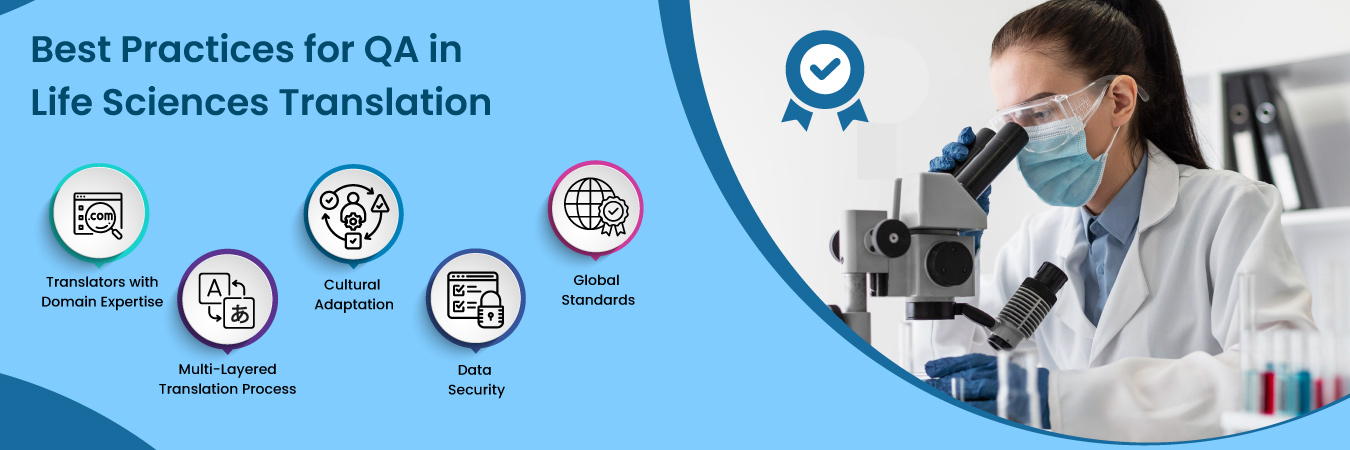
Quality Assurance in Life Sciences Translation Services – Best Practices
Life sciences deal with various critical aspects, including research about living beings, discovering new dimensions of life, innovating pharmaceuticals, etc. Accordingly, life sciences translations require being more careful and attentive to even the smallest details. They involve several best practices leading to the highest levels of accuracy and quality. Although partnering with experts can simplify translations, learning about some practices for quality assurance in life sciences translation services can help. Here are six major practices.
6 Best Practices in Quality Assurance in Life Sciences Translation Services
From appointing certified linguists and SMEs (Subject Matter Experts) to adhering to data security protocols, here are six things to do while ensuring quality.
1. Translators with Life Sciences Domain Expertise
Translators are at the heart of translation. Thus, you must employ qualified translators with unparalleled linguistic command and understanding of the life sciences domain. It would help you ensure accuracy across aspects like the regulatory language, medical terminologies, cultural nuances, etc.
Additionally, having SMEs would help complement the translator’s work and help enhance the technical accuracy of the translation. Also, providing ongoing training to keep translators updated on the latest industry developments and emerging terminologies is another wise practice.
2. Structured and Multi-Layered Translation Process
Fundamentally, translation is about converting text from one language to another. However, delving into it makes one realize and discover the various complexities involved in it. Thus, you must have a well-defined and multi-layered process that enhances quality and helps reduce errors. These layers, stages, or phases of the project include initial translation, editing, proofreading, and final review.
Each step needs a specialist. For instance, translations must be completed by a seasoned translator with some domain expertise. On the other hand, you would have a linguist reviewing the content and refining it to enhance its accuracy and style consistency. Then comes the proofreader who thoroughly checks parameters like punctuation, grammar, and formatting. Lastly, the final reviewer ensures compliance with SLAs, industry norms, and regulatory standards.
3. Using Translation Memory and Terminology Management Tools
Technology also plays a crucial role alongside humans in life sciences translation. It helps you maintain consistency and efficiency across every phase.
For example, tools like Translation Memory (TM) store previously translated segments to ensure consistency and save time. Additionally, using centralized repositories of approved terms specific to life sciences helps maintain uniformity of translation across documents. Besides, quality assurance software detects text inconsistencies, and missing translations and identifies formatting issues at various places. Blending them with human expertise and touch can help you take your translation quality to the next level!
4. Cultural Adaptation
Although life sciences translations are largely technical, one cannot discount or ignore the significance of cultural accuracy. Effective translations transcend word-for-word conversions, adapting content to align with cultural and regional contexts. Some considerations in this regard include ensuring translations respect local customs and beliefs. It is significant, particularly in patient-facing materials. In addition, checking measurements, dates, and regulatory references to suit the target audience’s locale is another important aspect.
5. Compliance with Global Standards
Life sciences projects usually work at a global scale. Accordingly, your translations must meet the established quality standards. Some commonly recognized benchmarks include ISO 17100, ISO 9001 Good Clinic Practice (GCP) and Good Manufacturing Practice (GMP). These standards focus on various aspects of translations, including resource qualifications, quality management systems, continuous improvements, etc.
6. Data Security and Confidentiality
Life sciences experts indulge in critical research and discoveries. Thus, the data with which they deal is sensitive and confidential. Maintaining data secrecy is as much a part of a translator’s job as that of others. Some best practices in this regard include using encrypted channels for sharing documents, entering NDAs (Non-Disclosure Agreements), and adhering to regulations, including GDPR for handling personal and sensitive data.
Filose – Exemplifying Quality in Life Sciences Translation Services!
Do you have a life sciences translation project and are looking for experts who can deliver premium-quality translations with shorter turnarounds?
Then, Filose is here to fit your requirements. We have the experience, best practices in life sciences translation services, and access to extensive human and technological resources to serve your needs. Our experts work dedicatedly on your project to deliver top translation quality on every front, thus contributing to your efforts in making a difference in the world. Please email us at sales@filose.com to learn more about our support and expertise.
Ref. No – FLB10241062
Contact Us
Are you looking for Language Services? Fill form for quick contact.
